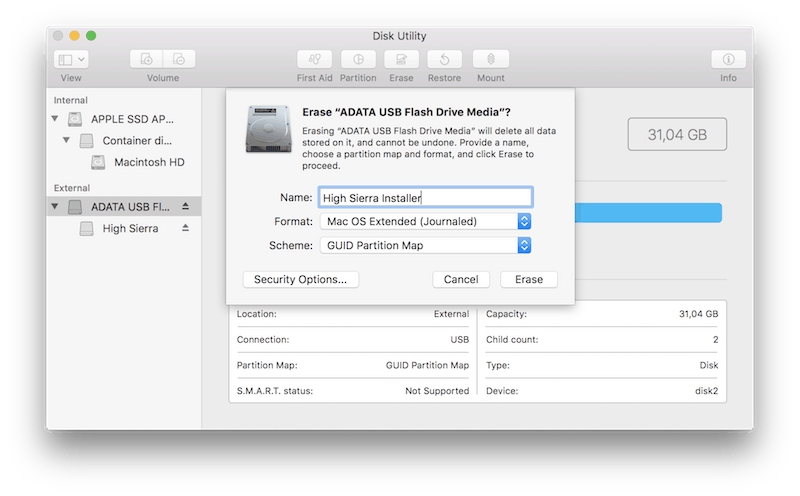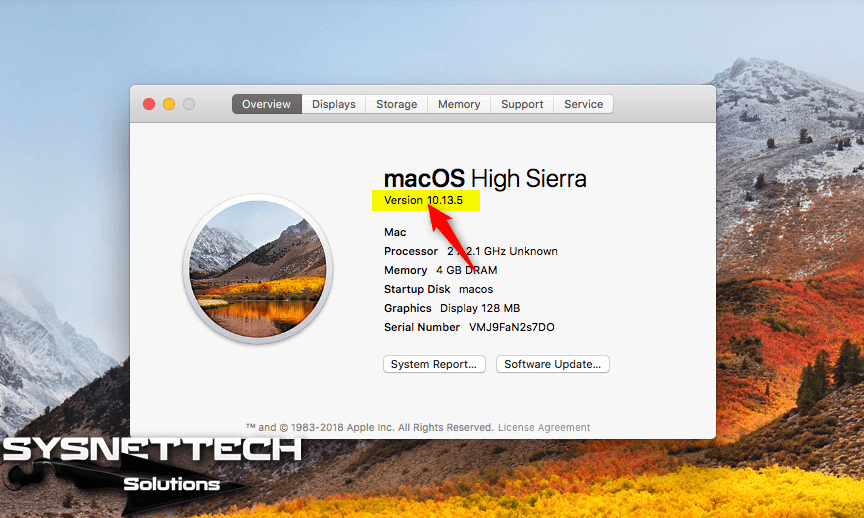- Install Mac Os High Sierra From Usb
- How Do I Install High Sierra From Usb
- Install Os X High Sierra From Usb
How To Download Mac OS High Sierra Without The App Store. Click the links above to either get the torrent or Mac OS High Sierra Download direct. Click Download button. If you have a MAC computer compatible with High Sierra. Install macOS Sierra downloads to application directory. When the download is done, the installer begins automatically. This will prompt Unibeast to begin installing to the USB drive. Once the installation process is complete, your USB drive will be ready to install macOS High Sierra on your PC. While the Unibeast installation finishes up, you should change your Windows computer's boot order. Some CPU models released in 2020 and later may require configuring the guest to 'Mac OS X (64-bit)' instead of 'macOS 10.13 High Sierra (64-bit)'. Performance and deployment After successfully creating a working macOS virtual machine, consider importing it into more performant virtualization software, or packaging it for configuration. Download MacOS High Sierra (from apple site) How to install MacOS High Sierra on Virtual Machine. First of all, download and install VirtualBox or Vmware on your computer (Windows or any other) And then download the MacOS high sierra. This file will be in zip format. And so you need to extract it by using WinRAR or any other tool.
These advanced steps are primarily for system administrators and others who are familiar with the command line. You don't need a bootable installer to upgrade macOS or reinstall macOS, but it can be useful when you want to install on multiple computers without downloading the installer each time.
What you need to create a bootable installer
- A USB flash drive or other secondary volume formatted as Mac OS Extended, with at least 14GB of available storage
- A downloaded installer for macOS Big Sur, Catalina, Mojave, High Sierra, or El Capitan
Download macOS
- Download: macOS Big Sur, macOS Catalina, macOS Mojave, or macOS High Sierra
These download to your Applications folder as an app named Install macOS [version name]. If the installer opens after downloading, quit it without continuing installation. To get the correct installer, download from a Mac that is using macOS Sierra 10.12.5 or later, or El Capitan 10.11.6. Enterprise administrators, please download from Apple, not a locally hosted software-update server. - Download: OS X El Capitan
This downloads as a disk image named InstallMacOSX.dmg. On a Mac that is compatible with El Capitan, open the disk image and run the installer within, named InstallMacOSX.pkg. It installs an app named Install OS X El Capitan into your Applications folder. You will create the bootable installer from this app, not from the disk image or .pkg installer.
Use the 'createinstallmedia' command in Terminal
- Connect the USB flash drive or other volume that you're using for the bootable installer.
- Open Terminal, which is in the Utilities folder of your Applications folder.
- Type or paste one of the following commands in Terminal. These assume that the installer is in your Applications folder, and MyVolume is the name of the USB flash drive or other volume you're using. If it has a different name, replace
MyVolumein these commands with the name of your volume.
Big Sur:*
Catalina:*
Mojave:*
High Sierra:*
El Capitan:
* If your Mac is using macOS Sierra or earlier, include the --applicationpath argument and installer path, similar to the way this is done in the command for El Capitan.

After typing the command:
- Press Return to enter the command.
- When prompted, type your administrator password and press Return again. Terminal doesn't show any characters as you type your password.
- When prompted, type
Yto confirm that you want to erase the volume, then press Return. Terminal shows the progress as the volume is erased. - After the volume is erased, you may see an alert that Terminal would like to access files on a removable volume. Click OK to allow the copy to proceed.
- When Terminal says that it's done, the volume will have the same name as the installer you downloaded, such as Install macOS Big Sur. You can now quit Terminal and eject the volume.
Use the bootable installer
Determine whether you're using a Mac with Apple silicon, then follow the appropriate steps:
Apple silicon
- Plug the bootable installer into a Mac that is connected to the internet and compatible with the version of macOS you're installing.
- Turn on your Mac and continue to hold the power button until you see the startup options window, which shows your bootable volumes and a gear icon labled Options.
- Select the volume containing the bootable installer, then click Continue.
- When the macOS installer opens, follow the onscreen instructions.
Intel processor
- Plug the bootable installer into a Mac that is connected to the internet and compatible with the version of macOS you're installing.
- Press and hold the Option (Alt) ⌥ key immediately after turning on or restarting your Mac.
- Release the Option key when you see a dark screen showing your bootable volumes.
- Select the volume containing the bootable installer. Then click the up arrow or press Return.
If you can't start up from the bootable installer, make sure that the External Boot setting in Startup Security Utility is set to allow booting from external media. - Choose your language, if prompted.
- Select Install macOS (or Install OS X) from the Utilities window, then click Continue and follow the onscreen instructions.
Learn more
For more information about the createinstallmedia command and the arguments that you can use with it, make sure that the macOS installer is in your Applications folder, then enter the appropriate path in Terminal:
- Big Sur: /Applications/Install macOS Big Sur.app/Contents/Resources/createinstallmedia
- Catalina: /Applications/Install macOS Catalina.app/Contents/Resources/createinstallmedia
- Mojave: /Applications/Install macOS Mojave.app/Contents/Resources/createinstallmedia
- High Sierra: /Applications/Install macOS High Sierra.app/Contents/Resources/createinstallmedia
- El Capitan: /Applications/Install OS X El Capitan.app/Contents/Resources/createinstallmedia
A bootable installer doesn't download macOS from the internet, but it does require an internet connection to get firmware and other information specific to the Mac model.
Longtime macOS users will know that even though the Mac has a built-in recovery partition, it’s always useful to have a dedicated USB drive with a macOS installer. I am a big fan of using a tool like DiskMaker X to create them to keep around if I need to wipe a drive and reinstall macOS quickly. If you have a drive created for Mojave, Sierra, and High Sierra, know that a certificate has expired. If you are getting an error similar to “This copy of the Install macOS Mojave.app application is damaged, and can’t be used to install macOS”, read on to learn how to fix it.
Install Mac Os High Sierra From Usb
If you’re getting the above error message when you go to install macOS, you’ll likely experience some panic about what to do. Thankfully, it’s an easy fix. As first reported by OSXDaily.com, a fix is quite simple.
The cause of this error is an expired certificate, and because the certificate is expired, the “Install macOS” app for Mojave, Sierra, and High Sierra will not run. Fortunately, there is a fairly simple solution to the “damaged” installer problem.
Below are the download links for the recent versions of macOS.
You may need to reboot the Mac after you have downloaded the new (and valid certificate) installer application, particularly if you had already launched a version that showed the application damaged error message.
If you are new to making macOS boot drives, we’ve got articles to help.
Another benefit to making a new boot drive is that you’ll get all of the various macOS updates that have been released since you made your last one. It’ll make your installation process a lot faster if you are recovering from a dead hard drive, since you won’t need to install macOS and then apply patches right afterward. While the process of repairing the “This copy of the Install macOS Mojave.app application is damaged, and can’t be used to install macOS” isn’t fun, thankfully, it’s easy.
How Do I Install High Sierra From Usb
Install Os X High Sierra From Usb
FTC: We use income earning auto affiliate links.More.

